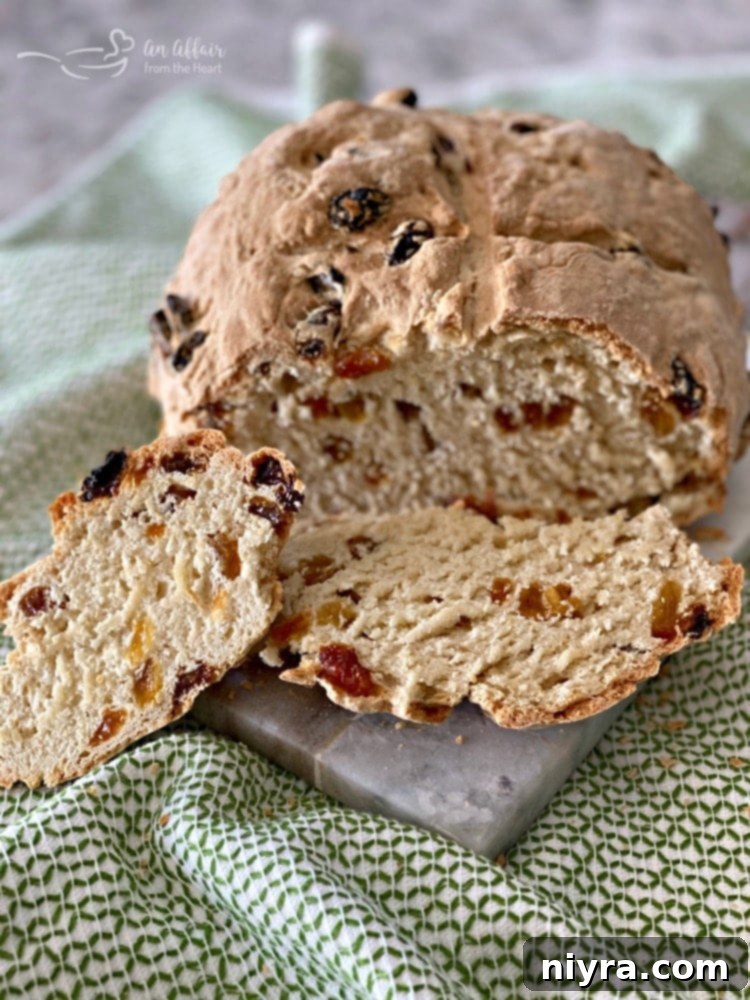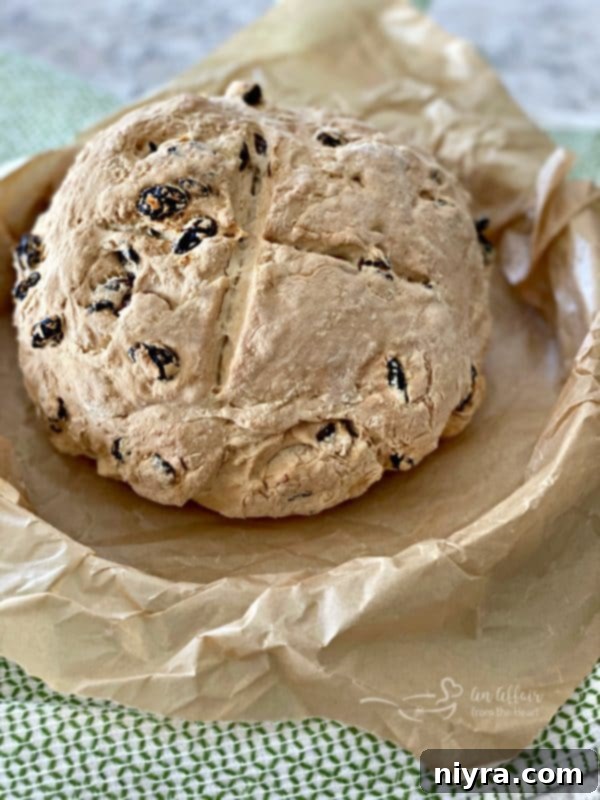
Discover the Charm of Traditional Irish Soda Bread
Step into the heart of Irish culinary tradition with a loaf of homemade Irish Soda Bread. This beloved staple is celebrated for its simplicity and the speed with which it can be prepared. Unlike conventional yeast breads that demand hours of rising time, Irish Soda Bread relies on a clever chemical reaction to achieve its signature texture, requiring no waiting whatsoever. It’s a beautifully forgiving bread, perfect for novice bakers and seasoned pros alike, making it an excellent choice for a quick, comforting addition to any meal.
Our recipe yields a subtly sweet white bread, distinguished by its wonderfully crusty exterior and a tender, soft crumb within. While many versions are famously studded with sweet raisins, others incorporate the distinctive anise-like flavor of caraway seeds. The beauty of this traditional recipe lies in its accessible ingredients: basic pantry staples like flour, a touch of sugar, baking soda, baking powder, and buttermilk are all you need to create a truly authentic loaf.
The Science Behind “Soda” Bread
The name “soda bread” isn’t just a quaint title; it perfectly describes the scientific secret behind this quick bread. The star leavening agent is baking soda, often referred to as “bread soda” in Ireland. When baking soda (sodium bicarbonate) is combined with an acidic ingredient, like buttermilk, it produces carbon dioxide bubbles. These bubbles are what cause the bread to rise, creating a light yet dense texture without the need for yeast or lengthy fermentation processes. This ingenious method means you can go from mixing bowl to warm, freshly baked bread in just over an hour!
More Than Just a St. Patrick’s Day Treat
While Irish Soda Bread is an undisputed star of St. Patrick’s Day celebrations, perfectly complementing a traditional Corned Beef & Cabbage meal, its versatility extends far beyond this annual holiday. Imagine a crisp autumn evening, a warm slice of this bread served alongside a hearty bowl of chili, or a creamy potato soup. Its sturdy texture and subtle sweetness make it an ideal companion for almost any savory dish. I particularly love it served warm with a steaming bowl of rich, creamy soup, much like the delicious Creamy Corned Beef & Cabbage Soup pictured here. It’s truly a bread for all seasons and countless meals.
My Journey with Irish Soda Bread

For many years, St. Patrick’s Day has held a special place in my heart, especially as a member of the Food Committee at our St. Patrick’s Parish. Each year, our church hosts a grand St. Patrick’s Day dinner, a highlight for our community. A few years ago, when the committee sought volunteers to bake Irish Soda Bread, I eagerly offered to contribute. At that time, my bread-baking experience was limited, mostly to beloved quick breads like Banana Bread. Taking on this Irish classic felt like a fun new challenge!
What drew me to this particular recipe, and what I’ve cherished about it ever since, is the perfect balance of sweetness it offers. A modest amount of sugar combined with the natural sweetness of raisins creates a flavor profile that is comforting and incredibly satisfying. I truly adore raisins in baking, and they shine beautifully in this bread. Over the years, I’ve experimented with both regular dark raisins and golden raisins, and I can assure you that either works wonderfully, so feel free to use whichever you have on hand or prefer.
Save This Recipe!
Don’t let this delightful recipe get lost in the shuffle! Pin it to your favorite Pinterest board now so you can easily find it whenever the craving for warm, homemade Irish Soda Bread strikes.
Baking Simplified: Preparing Your Irish Soda Bread
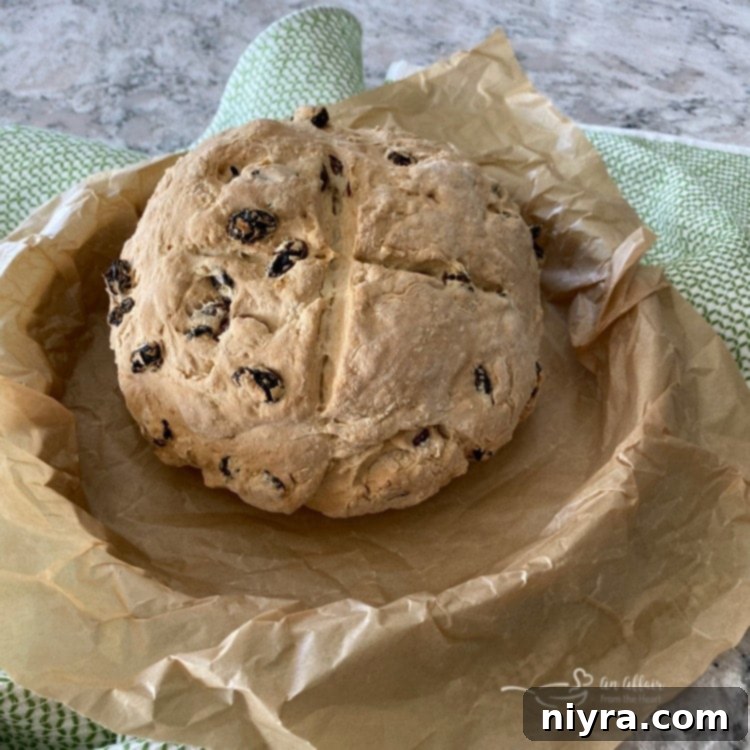
As I’ve emphasized, this Traditional Irish Soda Bread recipe is remarkably straightforward and requires no advanced baking skills. It’s the perfect entry point into bread making for anyone feeling intimidated by yeast or complex techniques. You don’t need to be an experienced bread baker to achieve a beautifully crusted, perfectly tender loaf.
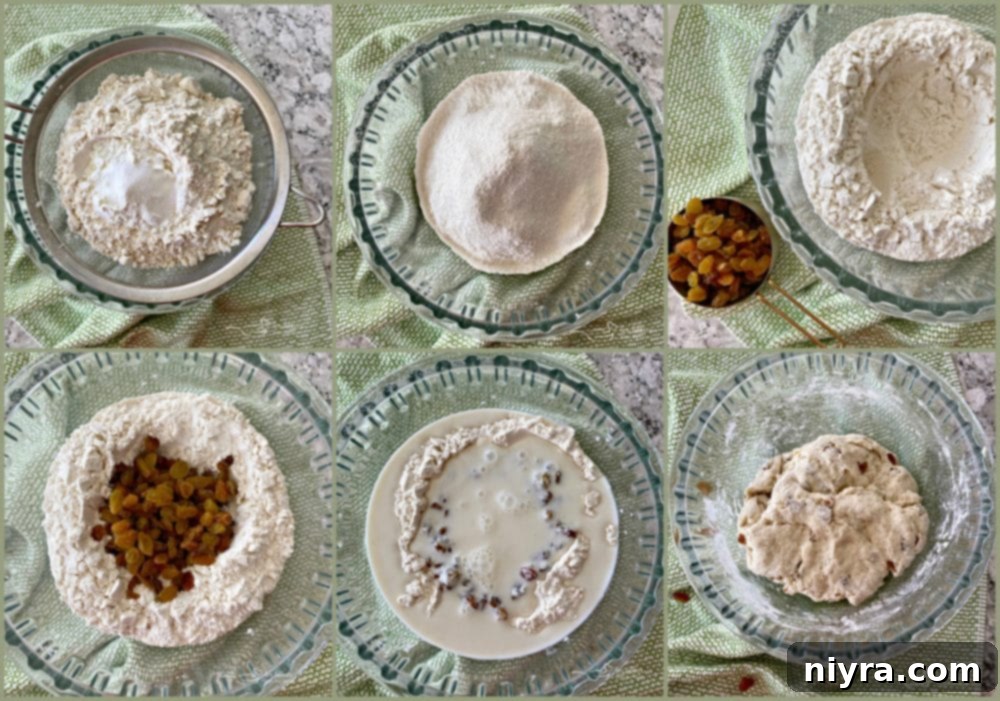
To begin, ensure you sift all your dry ingredients thoroughly into a large mixing bowl. Sifting helps to aerate the flour and ensures that the baking soda, baking powder, and salt are evenly distributed, leading to a consistent rise. Once sifted, create a “well” in the center of your dry mixture. This well is where you’ll introduce the wet ingredients, allowing for easier incorporation.
Next, add your chosen raisins (or caraway seeds if you prefer a more savory note) into the dry well, followed by the buttermilk. Mix these ingredients just until they come together. It’s important not to overmix here; the dough will be quite sticky, and that’s perfectly normal and desirable for a moist soda bread.

Turn the sticky dough out onto a lightly floured surface. Gently knead it about 10 times. The key here is *not* to over-knead. Unlike yeast breads that develop gluten with extensive kneading, soda bread can become tough if overworked. A few gentle kneads are all that’s needed to bring the dough together into a cohesive ball. Form the dough into a round, rustic loaf and carefully place it into your parchment-lined cake pan. Before baking, use a sharp knife to score a deep “X” into the top of the dough. This traditional mark not only allows the bread to expand beautifully during baking but is also said to ward off evil spirits in Irish folklore, making it a charming touch for an authentic loaf. Finally, bake until golden brown and cooked through.
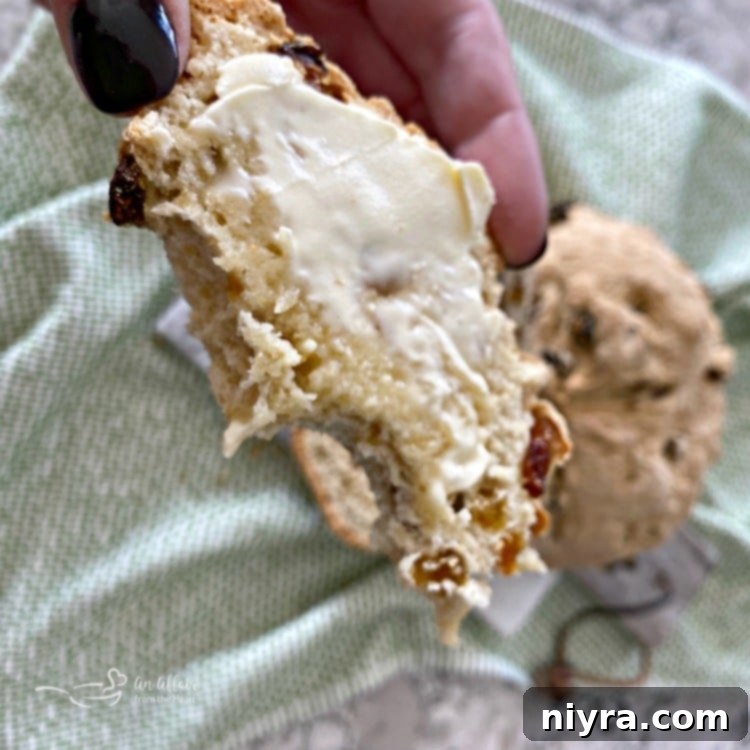
Once baked, your Irish Soda Bread will emerge with a beautiful golden crust, crunchy on the outside and wonderfully dense and soft on the inside. Slice it while still slightly warm and slather generously with creamy butter. For an extra touch of indulgence, add a dollop of your favorite jam or a drizzle of sweet honey. It’s also absolutely phenomenal when toasted the next day, bringing out even more of its delightful flavor and texture.
Effortless Buttermilk Substitute
Many traditional recipes, including this Irish Soda Bread, call for buttermilk. If you’re like me, buttermilk isn’t a pantry staple you always have on hand. While I use it in several recipes, it’s not often enough to justify buying a whole quart that might go to waste. The good news is, making your own buttermilk substitute is incredibly simple!

To create a quick and effective buttermilk substitute, simply add one tablespoon of white vinegar or lemon juice to a liquid measuring cup. Then, fill the rest of the cup with regular milk (whole milk works best, but 2% is also fine) until it reaches the desired amount. Stir lightly and let it sit for 5-10 minutes. The milk will curdle slightly, becoming a perfect stand-in for buttermilk, providing the necessary acidity to activate the baking soda. You can find more detailed instructions on my Buttermilk Substitute Recipe page.
Homemade Cake Flour Substitute
This particular Irish Soda Bread recipe suggests using cake flour, which contributes to its remarkably tender crumb. However, like buttermilk, cake flour isn’t always a common item in every home baker’s pantry. And if you don’t bake with it frequently, a box might expire before you get through it. The solution? Make your own fresh cake flour substitute!
You can easily create a suitable substitute for cake flour using all-purpose flour and cornstarch. For every cup of cake flour required, measure out one cup of all-purpose flour. Then, remove two tablespoons of that flour and replace it with two tablespoons of cornstarch. Sift the mixture together thoroughly to combine, and you’ll have a perfect cake flour substitute ready for your baking needs. For this recipe, which calls for 3 cups of cake flour, you would remove 6 tablespoons of all-purpose flour and add 6 tablespoons of cornstarch, then sift well. This simple trick ensures you can enjoy the delicate texture of this soda bread without a special trip to the store.
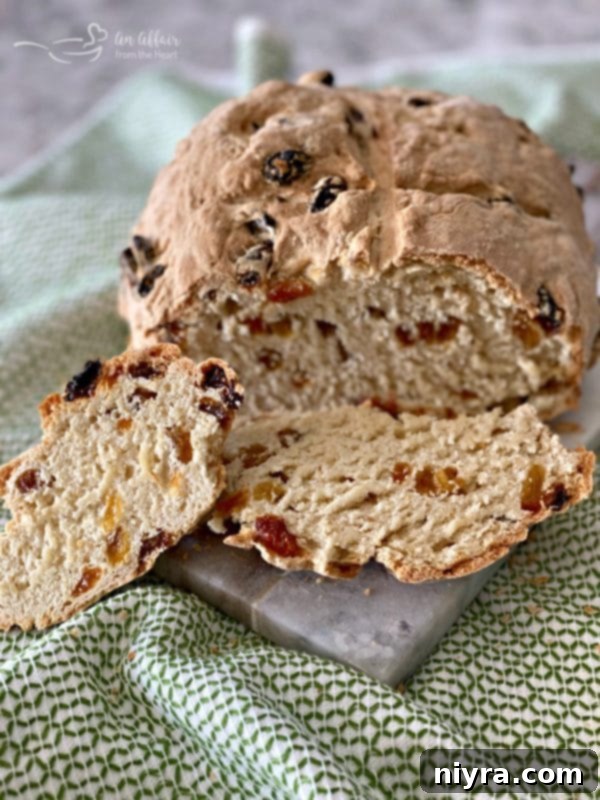
Explore More Delicious Recipes
I hope you’re excited to try this delightful Traditional Irish Soda Bread recipe! Beyond this comforting loaf, my blog is brimming with a wide array of recipes to inspire your culinary adventures. If you’re planning more festive meals, be sure to browse my collection of St. Patrick’s Day Recipes. And for fellow bread enthusiasts, you’ll find oodles of other Bread Recipes that are sure to become new favorites. Don’t hesitate to stay a while and explore all the delicious possibilities!
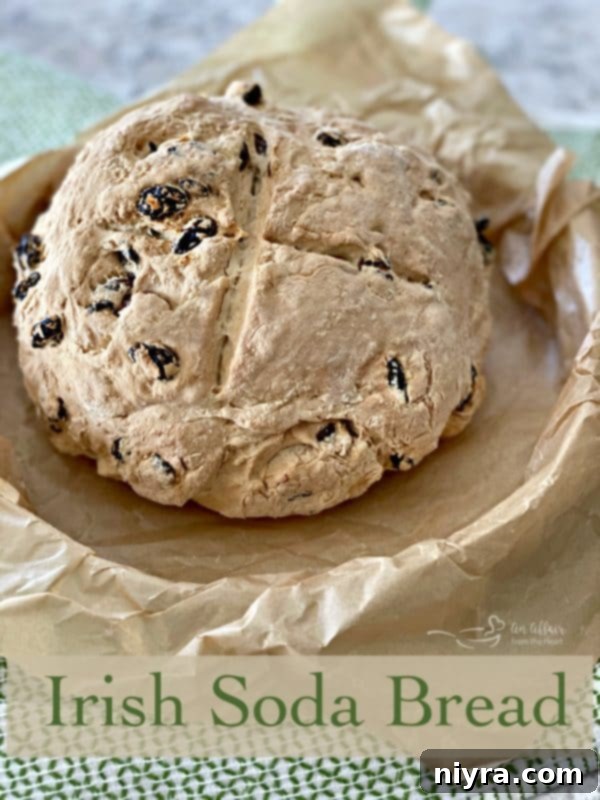
Now, let’s get baking! This quick and simple Irish Soda Bread with Raisins recipe promises you’ll be savoring warm, homemade bread in just over an hour. Enjoy every delicious bite!

LIKE THIS RECIPE?
Don’t forget to give it a ⭐️⭐️⭐️⭐️⭐️ star rating and
leave a comment below the recipe!
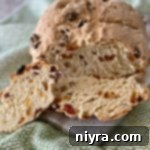
Print Recipe
Irish Soda Bread
Ingredients
- 3 cups sifted cake flour *
- 3 Tablespoons of sugar
- 1/2 teaspoon baking soda
- 1/2 teaspoon baking powder
- 1 teaspoon salt
- 1 cup raisins regular or golden are fine
- 1 1/3 cup of buttermilk **
Instructions
- Preheat oven to 350 degrees F (175 degrees C). Line a 9-inch cake pan with parchment paper.
- Sift all of the dry ingredients (cake flour, sugar, baking soda, baking powder, salt) into a large mixing bowl. Form a “well” in the center of the flour mixture.
- Add raisins and buttermilk to the well, and combine gently until just mixed. The dough will be sticky. Avoid overmixing.
- Turn the dough onto a lightly floured board and knead briefly, about 10 times, just to bring it together. Do not over-knead.
- Form the dough into a round, rustic circle, and place it in the prepared pan. With a sharp knife, score a deep “X” into the top of the dough.
- Bake for 60-65 minutes, or until the top is golden brown and a wooden skewer inserted into the center comes out clean.
- Cool slightly on a wire rack before slicing and serving.
Notes
** If you don’t have buttermilk on hand, make your own using whole milk and either lemon juice or vinegar. Add 1 1/3 Tablespoons of lemon juice or white vinegar to a liquid measuring cup, then fill with milk to the 1 1/3 cup line. Let stand for 5-10 minutes until slightly curdled. For a detailed guide, see our Buttermilk Substitute Recipe.
Irish Soda Bread is best enjoyed fresh. It WILL NOT KEEP for long; consume bread within 1-2 days for optimal freshness. Store any leftovers at room temperature, tightly wrapped.
Nutrition
Calories: 186kcal |
Carbohydrates: 41g |
Protein: 4g |
Fat: 1g |
Cholesterol: 1mg |
Sodium: 303mg |
Fiber: 1g |
Sugar: 12g
This post was originally published in March of 2013 and was updated in March of 2020 to upgrade user experience and provide more helpful tips. The original recipe was inspired by Green Eggs and Spam.
